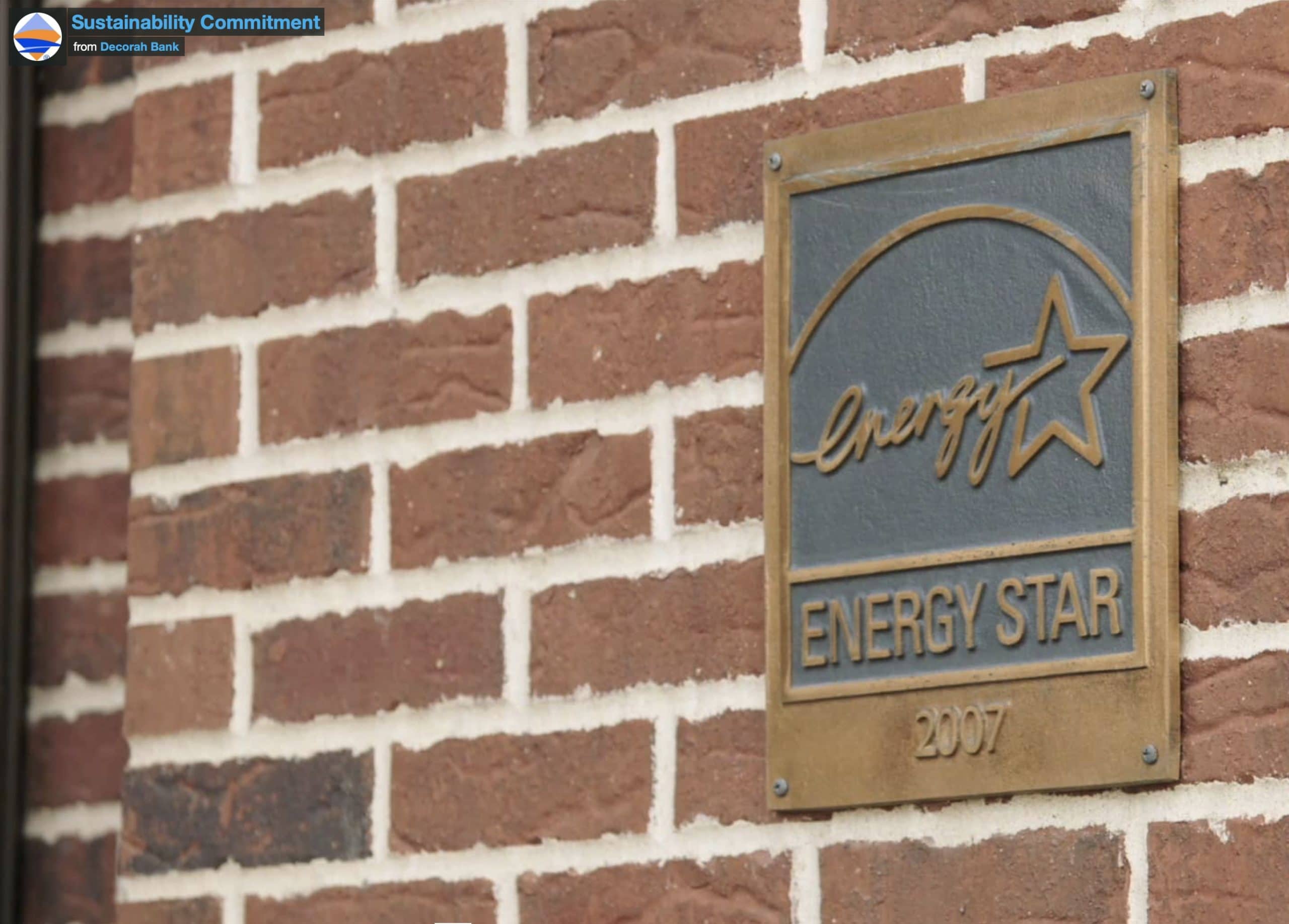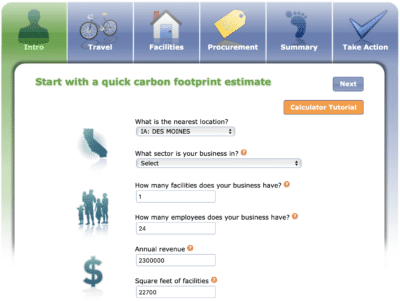
The Decorah Bank and Trust Company in Decorah, IA has reached a major milestone that few businesses can claim: its operations are officially carbon neutral. The achievement, reached in late 2019, capped more than a decade of sustainability efforts in line with the vision of Larry Grimstad, the bank’s retired founder and a local leader in renewable energy development.
When brothers Joe and Ben Grimstad took over management of the bank from their father in 2002, they sought to carry on Larry’s dedication to sustainable living and business practices. According to Joe, Larry has impressed that ethic on them their entire lives.
“[Our dad] encouraged us to be ‘future thinkers’ since childhood,” Joe Grimstad, the Bank’s Vice President, wrote in an email. “He demonstrated that business decisions based on what the future is likely to hold tend to result in business success, and we continue that approach to managing the bank.”
A prerequisite for becoming carbon neutral is the calculation of a carbon footprint – the total amount of CO2 emissions produced by a given entity. According to Joe, calculating the bank’s carbon footprint contributed greatly to their determination to achieve neutrality.
“Naturally, once you ‘keep score’ it becomes your mission to improve that score,” Joe said. “When we recalculated our footprint in 2018, we realized it had become within reach to completely eliminate it.”
The bank achieved carbon neutrality using a variety of methods. Electricity produced from burning fossil fuels was the primary target for elimination given that it accounted for over half of the bank’s carbon footprint. The bank enacted energy conservation measures that included tightening the building’s envelope, installing 100% LED lighting, and implementing programmable HVAC controls. These steps reduced the amount of electricity needed to operate their facilities. The bank’s two largest buildings were already both Energy Star Certified. The bank also installed solar panels on all three of its properties to further reduce their use of electricity generated from fossil fuels.
The bank eliminated the remainder of its carbon footprint through the purchase of carbon offsets from the Winneshiek Energy District—a local non-profit organization dedicated to leading the community in the transition away from fossil fuels. (Note: As of this writing, Larry Grimstad serves as a member of the Board.) Carbon offsets are credits available for purchase that represent reduced emissions elsewhere. They are an attractive option for those pursuing carbon neutrality because they allow buyers to fund emission reductions more efficiently. This is because most businesses or households will prioritize emission reduction efforts that are most cost effective so that as reductions continue they tend to get more expensive. For example, while the first 10% of reductions might be achieved by inexpensive efficiency changes (e.g. LED lights), the subsequent reductions are often much more costly (e.g. buying an electric vehicle fleet). Offsets allow companies to purchase emissions reductions to be implemented where they are cheaper, e.g. instead of buying a fleet of electric vehicles, the bank might pay for LED light replacements for other businesses and count those reductions towards its own footprint.
“We were pleasantly surprised at the ease of purchasing offsets to reach neutrality in 2019,” Joe said. “Not only do these offsets benefit us, but equally as important, they provide energy and money savings to others in our area. We have found them to be a win-win proposition.”
State and federal tax credits for solar production also aided the bank’s efforts. Iowa businesses that take advantage of these benefits can write off 65-75% of the costs associated with solar implementation on their taxes (although these benefits will start declining in 2020). The bank’s surrounding community also provides ongoing support for environmental progress.
“Members of the community have frequently reinforced our decisions through encouragement,” Joe said. “We have folks telling us this is why they have chosen us as their bank.”
While most consumers throughout America say that sustainability plays at least some role in their purchasing decisions, the Decorah community is especially active in efforts to preserve the environment. Winneshiek County (in which Decorah is the largest town) has the highest per capita rate of residential solar systems in the state. Many local businesses also have solar panels. Local Luther College ranks in the top five private universities in the country in terms of solar electricity and in 2011 installed a 1.6 megawatt wind turbine near campus. In all, Decorah is a community where businesses can rely on public support for sustainability efforts. Joe maintains, however, that an encouraging community should not make or break efforts to pursue sustainability.
“Community support is helpful, but even without it, we all need to do these things because it’s just the right thing to do,” Joe said. “I think most communities are at least starting to accept climate change as a real problem. Those that have not likely will do so in the near future.”
Joe hopes that more households and businesses will begin pursuing similar goals. Indeed, many large businesses have begun to move in the direction of sustainable practices in recent years. However, few have set goals satisfying the requirement set out by the IPCC (Intergovernmental Panel on Climate Change) of cutting emissions in half by 2030 to avoid the most severe forms of environmental catastrophe.
Still, Joe is optimistic that the bank’s strategy can be applied elsewhere, noting that the bank’s approach has followed universally-recommended and accessible guidelines that are best summed up as 1) implement efficiencies, 2) develop renewable energy alternatives, and 3) offset what can’t be eliminated.
Joe cautions that the journey towards carbon neutrality is difficult and can often feel slow – especially while trying to balance sustainability with growth.
“After ten years of implementing efficiency measures and building solar arrays, we were disappointed in 2018 that we had only eliminated 20% of our original footprint,” Joe said. “However, once we considered how much we had grown our operation during those years, 20% reduction sounded like a significant achievement.”
Even after reaching carbon neutrality, the bank isn’t done working to lessen their environmental impact. The bank’s next steps are to transition from offsets to more efficient practices while remaining open to other opportunities that may arise.
Joe sees business efforts like the bank’s—in conjunction with government—as playing a crucial role in the societal transition towards sustainability.
“I think the role of government should primarily be to endorse the science and educate society on the issues at a minimum,” Joe said. “I’ve read that aversion [of ecological crisis] is only possible if there are societal changes made. Businesses can be leaders in that change.”
Problem Addressed: Climate Change
Written by Forrest Stewart
Published: July 1, 2020
Updated: October 25, 2022
Sources
Joe Grimstad, email interview with Forrest Stewart, Jan 29, 2020 plus follow-up exchanges
University of Michigan Center for Sustainable Systems, “CARBON FOOTPRINT FACTSHEET”, 2019, http://css.umich.edu/factsheets/carbon-footprint-factsheet, accessed Feb 19, 2020
Green Building Advisor, “The Building Envelope”, https://www.greenbuildingadvisor.com/green-basics/the-building-envelope, accessed Feb 16, 2020
Energy.gov, “How Energy-Efficient Light Bulbs Compare with Traditional Incandescents”, https://www.energy.gov/energysaver/save-electricity-and-fuel/lighting-choices-save-you-money/how-energy-efficient-light, accessed Feb 16, 2020
Energy.gov, “Thermostats”, https://www.energy.gov/energysaver/thermostats, accessed Feb 16, 2020
Energystar.gov, “ENERGY STAR certification for your building”, https://www.energystar.gov/buildings/facility-owners-and-managers/existing-buildings/earn-recognition/energy-star-certification, accessed Feb 16, 2020
Olivia Rosane, “Carbon Offsets 101: Why We Can’t Offset Our Way Out of the Climate Crisis”, EcoWatch, updated Oct 21, 2022, https://www.ecowatch.com/carbon-offsets-climate-crisis.html, accessed Oct 25, 2022
Winneshiek Energy District, “About”, https://energydistrict.org/about/, accessed Feb 7, 2020
Daniel J. Weiss, Kalen Pruss, “Harvesting Low-Hanging Energy Savings”, Center for American Progress, Mar 10, 2009, https://www.americanprogress.org/issues/green/news/2009/03/10/5780/harvesting-low-hanging-energy-savings/, accessed Feb 16, 2020
EPA, “Carbon Footprint Calculator”, https://www3.epa.gov/carbon-footprint-calculator/, accessed Feb 18, 2020
Joe Grimstad, “Becoming Carbon Neutral; and How We Did It”, Decorah Bank and Trust Company, Nov 29, 2019, https://www.decorahbank.com/becoming-carbon-neutral-and-how-we-did-it/, accessed Jan 6, 2020
Carbon Footprint, “Carbon Neutrality”, https://www.carbonfootprint.com/carbonneutrality.html, accessed Feb 18, 2020
CO2nsensus, “10 Steps to Make Your Business Carbon Neutral”, https://www.co2nsensus.com/make-your-business-carbon-neutral, accessed Feb 19, 2020
Duncan Clark, “A complete guide to carbon offsetting”, The Guardian, Sep 16, 2011, https://www.theguardian.com/environment/2011/sep/16/carbon-offset-projects-carbon-emissions, accessed Feb 16, 2020
Renee Cho, “The 35 Easiest Ways to Reduce Your Carbon Footprint”, Earth Institute, Dec 27, 2018, https://blogs.ei.columbia.edu/2018/12/27/35-ways-reduce-carbon-footprint/, accessed Feb 18, 2020
Winneshiek Energy District, “Solar Tax Incentives”, https://energydistrict.org/resources/solar/solar-tax-incentives/, accessed Jun 15, 2020
CGS, “CGS Survey Reveals Sustainability Is Driving Demand and Customer Loyalty”, GlobeNewswire, Jan 10, 2019, https://www.globenewswire.com/news-release/2019/01/10/1686144/0/en/CGS-Survey-Reveals-Sustainability-Is-Driving-Demand-and-Customer-Loyalty.html, accessed Jun 15, 2020
Winneshiek Energy District, “Winneshiek County Solar Map”, https://energydistrict.org/resources/winneshiek-county-solar-map/, accessed Jun 15, 2020
Center for Sustainable Communities, “Solar Photovoltaic (PV) Systems”, Luther College, Feb 4, 2020, https://www.luther.edu/sustainability/energy-climate/renewable/solar-pv-systems/, accessed Jun 16, 2020
Center for Sustainable Communities, “Wind Energy”, Luther College, Feb 4, 2020, https://www.luther.edu/sustainability/energy-climate/renewable/wind-energy/, accessed Jun 16, 2020
Blake Morgan, “101 Companies Committed To Reducing Their Carbon Footprint”, Forbes, Aug 26, 2019, https://www.forbes.com/sites/blakemorgan/2019/08/26/101-companies-committed-to-reducing-their-carbon-footprint/#72096ae8260b, accessed Jun 16, 2020
Intergovernmental Panel on Climate Change, “Global Warming of 1.5 ºC”, 2018, https://www.ipcc.ch/sr15/, accessed Jun 16, 2020
Have a Suggestion?
Know a leader? Progress story? Cool tool? Want us to cover a new problem?


